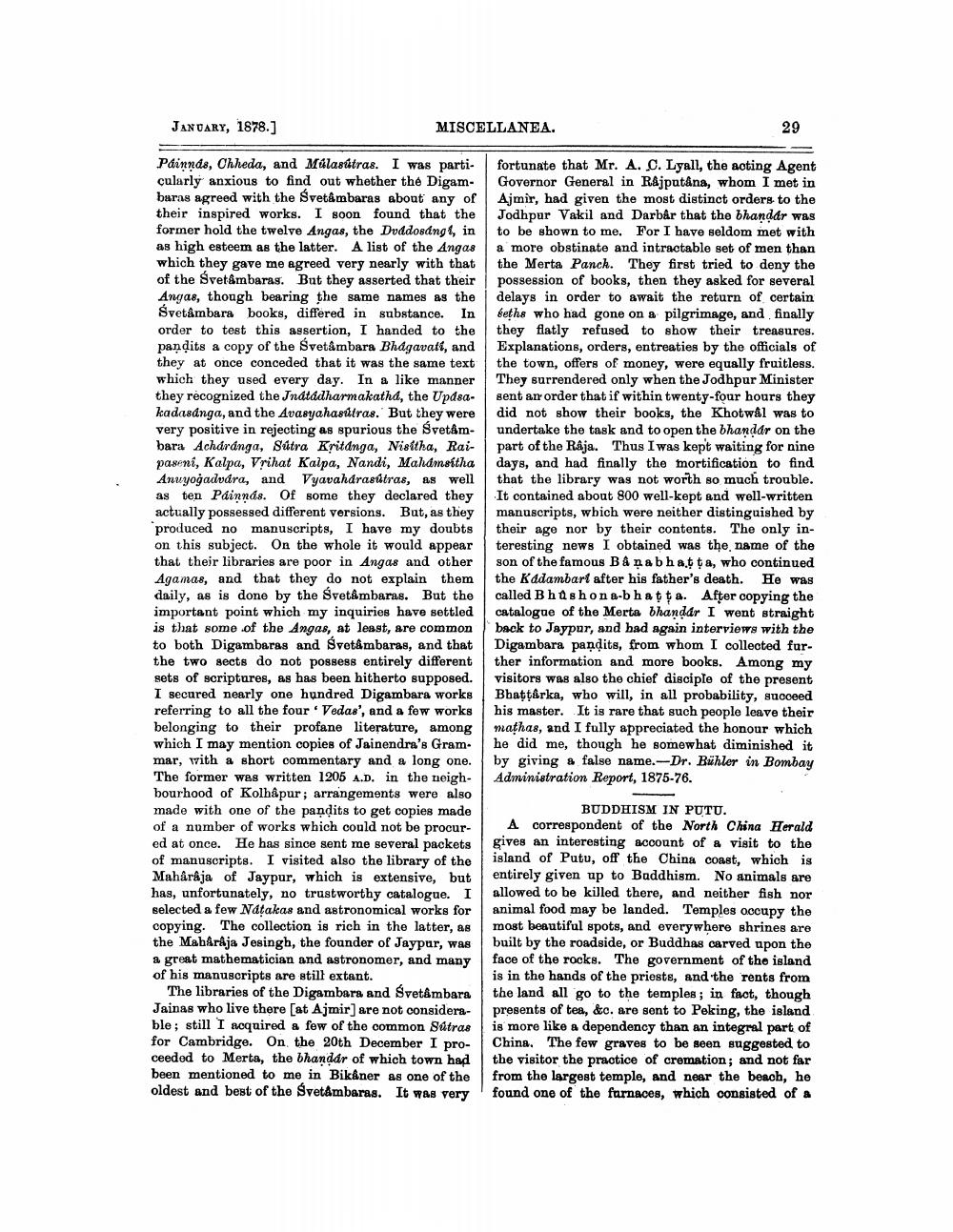________________
JANUARY, 1878.]
MISCELLANEA.
29
Páinnds, Chheda, and Múlasútras. I was particularly anxious to find out whether the Digambaras agreed with the Svetâmbaras about any of their inspired works. I soon found that the former hold the twelve Angas, the Dvddosdngt, in as high esteem as the latter. A list of the Angas which they gave me agreed very nearly with that of the SvetAmbaras. But they asserted that their Angas, though bearing the same names as the Svetâmbara books, differed in substance. In order to test this assertion, I handed to the pandits a copy of the Svetambara Bhagavati, and they at once conceded that it was the same text which they used every day. In a like manner they recognized the Jnatadharmakatha, the Updsa. kadasdnga, and the Avasyahasútras. But they were very positive in rejecting as spurious the SvetAmbara Acháránga, Sútra Kritanga, Nisitha, Raipaseni, Kalpa, Vrihat Kaipa, Nandi, Mahamsitha Anuyoġadvdra, and Vyavahdrasutras, as well as ten Pdinnds. Of some they declared they actually possessed different versions. But, as they produced no manuscripts, I have my doubts on this subject. On the whole it would appear that their libraries are poor in Angas and other Agamas, and that they do not explain them daily, as is done by the Svetâmbaras. But the important point which my inquiries have settled is that some of the Angas, at least, are common to both Digambaras and Svetâmbaras, and that the two sects do not possess entirely different sets of scriptures, as has been hitherto supposed. I secured nearly one hundred Digambara works referring to all the four Vedas', and a few works belonging to their profane literature, among which I may mention copies of Jainendra's Grammar, with a short commentary and a long one. The former was written 1205 A.D. in the neigh- bourhood of Kolhapur; arrangements were also made with one of the pandits to get copies made of a number of works which could not be procured at once. He has since sent me several packets of manuscripts. I visited also the library of the Maharaja of Jaypur, which is extensive, but has, unfortunately, no trustworthy catalogue. I selected a few Natakas and astronomical works for copying. The collection is rich in the latter, as the Mabárája Jesingh, the founder of Jaypur, was a great mathematician and astronomer, and many of his manuscripts are still extant.
The libraries of the Digambara and Svetâmbara Jainas who live there [at Ajmir) are not considerable; still I acquired a few of the common Sátras for Cambridge. On the 20th December I proceeded to Merta, the bhandar of which town had been mentioned to me in Bikaner as one of the oldest and best of the Svetämbaras. It was very
fortunate that Mr. A. C. Lyall, the acting Agent Governor General in Rajputâna, whom I met in Ajmir, had given the most distinct orders to the Jodhpur Vakil and Darbar that the bhandar was to be shown to me. For I have seldom met with a more obstinate and intractable set of men than the Merta Panch. They first tried to deny the possession of books, then they asked for several delays in order to await the return of certain beths who had gone on a pilgrimage, and finally they flatly refused to show their treasures. Explanations, orders, entreaties by the officials of the town, offers of money, were equally fruitless. They surrendered only when the Jodhpur Minister sent arr order that if within twenty-four hours they did not show their books, the Khotwal was to undertake the task and to open the bhanddr on the part of the Raja. Thus I was kept waiting for nine days, and had finally the mortification to find that the library was not worth so much trouble. It contained about 800 well-kept and well-written manuscripts, which were neither distinguished by their age nor by their contents. The only interesting news I obtained was the name of the son of the famous B & nabhat ta, who continued the Kadambart after his father's death. He was called Bhoshona-bhatta. After copying the catalogue of the Merta bhandar I went straight back to Jaypur, and had again interviews with the Digambara pandits, from whom I collected further information and more books. Among my visitors was also the chief disciple of the present Bhattarka, who will, in all probability, succeed his master. It is rare that such people leave their mathas, and I fully appreciated the honour which he did me, though he somewhat diminished it by giving a false name.-Dr. Bühler in Bombay Administration Report, 1875-76.
BUDDHISM IN PUTU. A correspondent of the North China Herald gives an interesting account of a visit to the island of Putu, off the China coast, which is entirely given up to Buddhism. No animals are allowed to be killed there, and neither fish nor animal food may be landed. Temples occupy the most beautiful spots, and everywhere shrines are built by the roadside, or Buddhas carved upon the face of the rocks. The government of the island is in the hands of the priests, and the rents from the land all go to the temples; in fact, though presents of tea, &c. are sent to Peking, the island is more like a dependency than an integral part of China. The few graves to be seen suggested to the visitor the practice of cremation; and not far from the largest temple, and near the beach, he found one of the furnaces, which consisted of a




